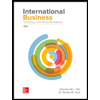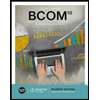Week 5 - Case Study 1
.docx
keyboard_arrow_up
School
Aurora University *
*We aren’t endorsed by this school
Course
4990
Subject
Business
Date
May 3, 2024
Type
docx
Pages
9
Uploaded by ProfessorPolarBear4361 on coursehero.com
Running Header: Week 5 Case Study #1
Week 5 Case Study #1
Antoinette Tuttle
Aurora University
BUS 4990: Contemporary Topics – Business Strategy & Planning
Professor Lauri Barnes
April 14, 2024
Week 5 Case Study #1
2
Success
“iRobot, the leading global consumer robot company, designs and builds robots that empower people to do more both inside and outside of the home” (iRobot, n.d., para. 2). iRobot’s
success in maintaining its leadership position in the consumer robotic industry is impressive. The
company's focus on technology and innovation, its entry into the smart home market, and its ability to create new ventures and partnerships have contributed to its success, but there are other
factors, as well. First, the firm has maintained its market position and seen consistent growth over the years thanks to its excellent distribution network and devoted customer base. Additionally, iRobot is known for producing reliable and high-quality robotic products that simplify daily tasks for consumers. Coupled with a strong focus on research and development (R&D), which has allowed it to develop innovative products and stay ahead of the competition, the combination of innovation, brand reputation, and market leadership has contributed to iRobot's success in the consumer robotics industry.
Still, there are some unattractive aspects of iRobot's success. One is the company's limited ability to develop and diversify due to its reliance on a single, rather basic product line. Furthermore, given that the market for consumer robots is currently very small and similar to that
of traditional home appliances, the company's emphasis on this sector of the industry may not be sustainable in the long run. In addition, Amazon attempted to acquire the company but was unsuccessful after posting a 20% loss in the fourth quarter of 2023 (Kalogeropoulos, 2024).
Analysis
To defend the assessment, a SWOT analysis is used. “A company’s internal strengths should always serve as the basis of its strategy—placing heavy reliance on a company’s best
Week 5 Case Study #1
3
competitive assets is the soundest route to attracting customers and competing successfully against rivals” (Gamble et al., 2020, pp. 70–71). Companies are urged to use a SWOT analysis to
look more thoroughly at their operations and management practices. By being aware of its strengths and weaknesses, the organization can make informed decisions that foster development, increase performance, and reinforce its competitive advantage. This method also helps the company identify its capabilities and opportunities for progress.
Strengths
The Roomba vacuum and the Braava floor mopping robots are only two of iRobot's well-
known, inventive home cleaning robot lines. These items' efficiency and practicality have won them a lot of praise. The performance levels, price tag, and availability of the units at local stores
have propelled them to the top of the market.
As a market leader in the robotics sector, iRobot has built a solid reputation for dependability, high standards, and innovative technologies. Having a sizable market share in the robotic vacuum and floor cleaning business, iRobot leads the consumer robotics market. Its products are accessible in many nations, giving them a large global customer base. With a plethora of knowledge in robotics and artificial intelligence (AI), iRobot can keep up with technological breakthroughs and improve its products constantly.
Weaknesses
As iRobot's primary revenue stream comes from the consumer sector, it is vulnerable to shifts in consumer purchasing habits and economic downturns. The company's reliance on a certain market segment may pose a risk to its financial survival.
Week 5 Case Study #1
4
The robotics industry is becoming more and more competitive as new and existing companies compete for market dominance. Businesses that provide comparable house cleaning services, and those venturing into robotics compete with iRobot. Even though iRobot's products are more convenient and have cutting-edge technology, their cost is more than that of conventional cleaning supplies. This price premium may make it more difficult for the business to draw in people on a tight budget, particularly in countries where prices are sensitive.
Opportunities
iRobot has the potential to provide more goods than just housecleaning robots. Looking at applications for elder care, commercial cleaning, or healthcare might open up new revenue streams and diversify the business. With the advancements in robotics, AI, and connectivity, iRobot will have the opportunity to enhance its products' functionality, increase productivity, and
maintain a competitive edge. With the expanding use of robotic technology in poorer countries, iRobot has enormous potential to expand its worldwide presence. Strategic relationships and focused marketing initiatives can help to spur growth in these areas.
Threats
As more companies enter the house cleaning robot market, there may be saturation and pressure on iRobot’s margins due to price competition. According to Polar Market Research (2022, para. 1), “the cleaning robot market was valued at USD 8.3 billion in 2021 and is expected to grow at a CAGR of 22.2% during the forecast period,” as illustrated in Figure 1. The demand for cleaning robots has increased as a result of the rising use of these machines in households and the introduction of automation and AI in domestic settings (Polaris Market Research, 2022).
Your preview ends here
Eager to read complete document? Join bartleby learn and gain access to the full version
- Access to all documents
- Unlimited textbook solutions
- 24/7 expert homework help
Related Questions
Topic: principle of Marketing the new product development processPlease to answer question below base on the example given to me, explain thoroughly ExampleIn Kingston, Jamaica, a good example of a new product development process is the recent launch of the Wisynco Eco line of products. Wisynco, a local beverage company, developed a new line of eco-friendly products, including a reusable water bottle and a biodegradable straw. The new product development process likely involved idea generation from employees and market research, as well as concept development and testing with potential customers. The company also likely conducted a business analysis to determine the financial feasibility of the product, as well as product development and market testing before launching the products into the market.
What environmental trends or factors in the environmental would have prompted Wisynco to launch this new line?
arrow_forward
Recommendations for North East Link project in Victoria.
Recommendations on how to solve budget blowout.
Please include references.
arrow_forward
Directions: You were chosen to work as the country's risk management planner for the various tourism sectors. Prepare actionable procedures as the planner to prevent mishaps in the tourism industry.
How To Prevent Accidents the common injuries in the Amusement Park (15 points)
1. Death from falling (3 steps)
2. Improper Design of the Ride (3 steps)
3. Operational Failures (3 steps)
4. Employees or Workers at Fault (3 steps)
5. Head, neck, and back injuries (3 steps)
arrow_forward
S.I.T. CARE RENTAL: AN UPGRADE OPPORTUNITY IN TRINIDAD AND TOBAGO (IVEY case) Case learning objectives:This case gives students an opportunity to:• Complete the industry analysis and define its main characteristics and critical success factors;• Analyze a company’s internal capabilities, compare it to its competitors, and evaluate its main customer groups;• Justify a comprehensive and well-informed decision regarding an upgrade opportunity.
Organisation and methodology:Each student will be required to show his/her understanding of the concepts of the Strategic Management and analytical skills in the work with the case. On the basis of this analysis each student will have to write an individual report. The students will need to carefully read the case and after that the students will need to answer in a paper the following questions:
Question 1: How would you formulate the mission of SIT company? Question…
arrow_forward
5) We offered 50% of our drivers monetary bonuses to increase their activity. Compare the results with the control group and explain if the campaign was successful and should we do it again or not.
Condition: Stay online 30 hours and accept 75% of rides. Get 70€ bonus.
Control Group
Online hours
Offline hours
Bookings received
Bookings successfully completed
Bonus Group
Online hours
Offline hours
Bookings received
Bookings successfully completed
Write here your answer about the results of the campaign
Driver 1
15
35
15
13
Driver 55
33
19
29
25
Driver 2
29
21
30
Driver 56
5
55
6
6
Driver 3
17
23
12
10
Driver 57
32
8
19
16
Driver 4
31
19
31
26
Driver 58
32
18
29
26
Driver 5
36
24
44
24
Driver 59
38
22
20
17
Driver 6
14
26
10
12
Driver 60
17
23
10
9
Driver 7
5
40
5
4
Driver 61
4
46
3
3
Driver…
arrow_forward
Question 1: Assume that there are a total of six different market segments for the fitness center market. Take reference from the listed overview of the markets and answer the questions give below.
Overview:
Making friends: The “making friends” market segment sees fitness centers as an opportunity to mix with people with similar goals and lifestyles and to make new friends.
Losing it: The next market segment is “losing it”, which refers to the goal of losing weight.
Taking shape: The “taking shape” market segment consists of consumers who are primarily interested in improving the look of their body.
Peak performers: Consumers in the “peak performers” segment are highly disciplined and self-motivated individuals when it comes to their health and fitness. They are highly focused upon achieving their personal best.
Health requirements: Consumers in this market segment attend a fitness center because they are trying to improve their health, strength, or because of “doctor’s orders”.
Sports…
arrow_forward
Topic:
“What are some causes of rising food prices and the challenges faced by rural farmers in Mt. Royal, Carriacou.”
A. Based on the topic above, what are the theory/theories that provide an explanation for the problem you are studying?
arrow_forward
XYZ Company, a mid-sized manufacturing firm, is facing increased competition in its industry. The company produces electronic components and devices. Leadership has recognized the need to revisit and refine its strategic plan to maintain competitiveness and ensure sustainable growth.
Question- XYZ Company has decided to implement a new strategic plan. Outline the key steps the company should take to ensure successful implementation.
arrow_forward
Q1 (b). You are directed to design a Hierarchical Task Analysis (HTA) for the following scenario,
Plans and types of Plan should be mention separately,
An Accident occurred somewhere and the security officials were trying to conduct an investigation
of the accident. They initially collected the evidence and after making analysis and integrating the
facts some conclusions were drawn. Some recommendations were aligned after validation. However
in order to collect the evidence the official need to visit the site and the evidence after identification
must be preserved. Along with the evidence witness collection and interviewing those witnesses is
very important. And the integrated information is reviewed. Moreover, interviewing a witness needs
a proper place. The officials can provide a meeting room and let the witness explain the incident
details. Officials must ask some open ended questions that must ensure 5Ws (What, Where, Who,
When, Why) and 1H (How).
arrow_forward
PART 5: JIRO DREAMS OF SUSHIYou would need to watch a documentary film and think hard about quality management at chef master Jiro Ono's sushi restaurant, e.g. the Sukiyabashi Jiro in Tokyo, Japan.The film has the following information: titled Jiro Dreams of Sushi; first released in 2011; produced by Kevin Iwashina and Tom Pellegrini; directed by David Gelb; distributed by Magnolia PicturesTranscripts of the film are available online for free. Just follow this link:https://www.scripts.com/script/jiro_dreams_of_sushi_11319
In your report of this part, you need to present the following:
(c) Discussion on why the restaurant does not need a documented quality system.(d) Discussion on why this non-documentation system may not work in other organizations (not necessarily in the restaurant industry)
arrow_forward
Research topic: The study of customers’ behavior towards online shopping as opposed to in-store at a Supermarket.
The Problem: would there be a problem conducting such research topic? If so, what are the possible problems?
arrow_forward
10. CASE SYNOPSIS
As 2019 ended, the founder and chief executive officer (CEO) of this
Cosmetic Company had overseen phenomenal growth during the
firm's five years of operation. However, the company was about to
encounter a series of issues as a result of the global COVID-19
pandemic that resulted in lockdowns, stay-at-home orders, and
closures of non-essential businesses around the world. This
company, likemany other companies, suffered a severe decline in
revenue. How could this company overcome the uncertainty and
challenges that accompanied the pandemic?
Construct Strategically sound decision during a crisis that involves severe resource
constraints.
arrow_forward
10. CASE SYNOPSIS
As 2019 ended, the founder and chief executive officer (CEO) of this
Cosmetic Company had overseen phenomenal growth during the
firm's five years of operation. However, the company was about to
encounter a series of issues as a result of the global COVID-19
pandemic that resulted in lockdowns, stay-at-home orders, and
closures of non-essential businesses around the world. This
company, likemany other companies, suffered a severe decline in
revenue. How could this company overcome the uncertainty and
challenges that accompanied the pandemic?
Respond quickly to environmental changes to promote long term resilience and growth
arrow_forward
Question 1:
Risk Analysis is a critical function of an organization in order to sustain in this ever evolving and transforming world. Today organizational sustainability depends on investing in effective projects that could reap right results. Please reflect on how risk management can improve profitability in an organization.
arrow_forward
Recommendations, recommended action,justification,positive and negative effects. Please help.
arrow_forward
Directions: Given the excerpt from a research conducted by Herrero (2018), analyze the research instrument used based on the
following criteria.
NUMERACY INVENTORY DEVICE (NID): BASIS FOR CRAFTING STRATEGIC INTERVENTION MATERIALS (SIM) IN MATHEMATICS
Rico A. Herrero
Research Instrument
In order for the researcher to gather necessary data, the researcher devised a tool called the Numeracy Inventory Device (NID) which measured the students'
numeracy skills. This was composed of 80 items test which underwent validation by the mathematics experts such as master teachers, head teachers, etc. Moreover, in
order to establish not only the validity of the device but also the reliability, sophisticated item analysis was also conducted. Out of these 80 items, 50 good questions were
retained and became part of the device. The questions covered the following areas: Whole Numbers, Signed Numbers, Fractions, Decimals, and Percentages.
After establishing the device's validity and reliability, the…
arrow_forward
Question 4: Read the below scenario carefully and answer the questions?
YOU BE THE CONSULTANT
Ed Sabol, a once unhappy coat salesman, had a passion for filming his son's high school football
games and other activities. Word of Ed's filming abilities soon got around and he found himself
working a number of local high school games. This led to Ed's successful bid ($3,000) to film
the 1962 NFL championship game. Then Commissioner Pete Rozelle was so impressed with the
work that he agreed to Ed's proposal to create a new entity known as NFL Films that would both
preserve the history of the game and promote it to the nation's sports fans. NFL Films' creative
approach to the game has resulted in 82 Emmy Awards to date.
Ed retired in 1987, turning the reins over to his son Steve who has taken the company to new
heights thanks in part to his empowering leadership style and product innovation. The company
now has a 200,000 square foot state-of-the-art facility.
Q1. Identify the entrepreneurial…
arrow_forward
question 8
How do you manage the e-Commerce project?
arrow_forward
You are to read the case study as they appear in your text (See below) Question 1. What management, organization, and technology factors were responsible for McAfee’s software problem? Question 2. What was the business impact of this software problem, both for McAfee and for its customers? Question 3. If you were a McAfee enterprise customer, would you consider McAfee’s response to the problem be acceptable? Why or why not? Question 4. What should McAfee do in the future to avoid similar problems? WHEN ANTIVIRUS SOFTWARE CRIPPLES YOUR COMPUTERS: McAfee is a prominent antivirus software and computer security company based in Santa Clara, California. Its popular VirusScan product (now named AntiVirus Plus) is used by companies and individual consumers across the world, driving its revenues of $1.93 billion in 2009. A truly global company, McAfee has over 6,000 employees across North America, Europe, and Asia. VirusScan and other McAfee security products address endpoint…
arrow_forward
Topic 3: The Environment and corporate culture)
Q3. Describe the four types / categories of cultural values that are important for the organization, managers consider the external environment, as well as the company’s strategy and goals.
arrow_forward
Question 6
6. Why does new product development theory show the process as an inverted triargle, with the first stage at the top of the triangle?
O Because the number of ideas that will result in viable new products decreases as the process progresses.
O Because there are more stage gates in the early stages of the process.
O Because more money is spent in the early stages of the process than at later stages.
O Because each project's potential revenue decreases as it progresses through the process
Question 8
8. Southwest Airlines screens potential employees rigorously and uses several unique interview processes to hire the right people. Southwest also has an extensive training progran for new employees
These tactics reduce
in service delivery,
O Varlability
O Overtead costs
O Search qualities
O Corsintence
Question 10
2 pts
10. Ambient Management, Inc was experiencing a gap in the services it was providing. It dosed the gap by ensuring that its customer-facing staff had the skills,…
arrow_forward
Q2. Discuss the concept of time. How time can be manipulated and how does it help construct reality.
arrow_forward
15 18 1 Kurtosis is an indicator used to determine whether a distribution is left-skewed or right-skewed. the flatness or peakedness of a distribution. Owhether a distribution is normal or non-normal. the asymmetry and deviation from a normal distribution. Question 3 Listen Which tool should be used during the Improve stage to identify the impact a project recommendation will have on the organization?
arrow_forward
SEE MORE QUESTIONS
Recommended textbooks for you

BUSN 11 Introduction to Business Student Edition
Business
ISBN:9781337407137
Author:Kelly
Publisher:Cengage Learning

Essentials of Business Communication (MindTap Cou...
Business
ISBN:9781337386494
Author:Mary Ellen Guffey, Dana Loewy
Publisher:Cengage Learning

Accounting Information Systems (14th Edition)
Business
ISBN:9780134474021
Author:Marshall B. Romney, Paul J. Steinbart
Publisher:PEARSON


International Business: Competing in the Global M...
Business
ISBN:9781259929441
Author:Charles W. L. Hill Dr, G. Tomas M. Hult
Publisher:McGraw-Hill Education

Related Questions
- Topic: principle of Marketing the new product development processPlease to answer question below base on the example given to me, explain thoroughly ExampleIn Kingston, Jamaica, a good example of a new product development process is the recent launch of the Wisynco Eco line of products. Wisynco, a local beverage company, developed a new line of eco-friendly products, including a reusable water bottle and a biodegradable straw. The new product development process likely involved idea generation from employees and market research, as well as concept development and testing with potential customers. The company also likely conducted a business analysis to determine the financial feasibility of the product, as well as product development and market testing before launching the products into the market. What environmental trends or factors in the environmental would have prompted Wisynco to launch this new line?arrow_forwardRecommendations for North East Link project in Victoria. Recommendations on how to solve budget blowout. Please include references.arrow_forwardDirections: You were chosen to work as the country's risk management planner for the various tourism sectors. Prepare actionable procedures as the planner to prevent mishaps in the tourism industry. How To Prevent Accidents the common injuries in the Amusement Park (15 points) 1. Death from falling (3 steps) 2. Improper Design of the Ride (3 steps) 3. Operational Failures (3 steps) 4. Employees or Workers at Fault (3 steps) 5. Head, neck, and back injuries (3 steps)arrow_forward
- S.I.T. CARE RENTAL: AN UPGRADE OPPORTUNITY IN TRINIDAD AND TOBAGO (IVEY case) Case learning objectives:This case gives students an opportunity to:• Complete the industry analysis and define its main characteristics and critical success factors;• Analyze a company’s internal capabilities, compare it to its competitors, and evaluate its main customer groups;• Justify a comprehensive and well-informed decision regarding an upgrade opportunity. Organisation and methodology:Each student will be required to show his/her understanding of the concepts of the Strategic Management and analytical skills in the work with the case. On the basis of this analysis each student will have to write an individual report. The students will need to carefully read the case and after that the students will need to answer in a paper the following questions: Question 1: How would you formulate the mission of SIT company? Question…arrow_forward5) We offered 50% of our drivers monetary bonuses to increase their activity. Compare the results with the control group and explain if the campaign was successful and should we do it again or not. Condition: Stay online 30 hours and accept 75% of rides. Get 70€ bonus. Control Group Online hours Offline hours Bookings received Bookings successfully completed Bonus Group Online hours Offline hours Bookings received Bookings successfully completed Write here your answer about the results of the campaign Driver 1 15 35 15 13 Driver 55 33 19 29 25 Driver 2 29 21 30 Driver 56 5 55 6 6 Driver 3 17 23 12 10 Driver 57 32 8 19 16 Driver 4 31 19 31 26 Driver 58 32 18 29 26 Driver 5 36 24 44 24 Driver 59 38 22 20 17 Driver 6 14 26 10 12 Driver 60 17 23 10 9 Driver 7 5 40 5 4 Driver 61 4 46 3 3 Driver…arrow_forwardQuestion 1: Assume that there are a total of six different market segments for the fitness center market. Take reference from the listed overview of the markets and answer the questions give below. Overview: Making friends: The “making friends” market segment sees fitness centers as an opportunity to mix with people with similar goals and lifestyles and to make new friends. Losing it: The next market segment is “losing it”, which refers to the goal of losing weight. Taking shape: The “taking shape” market segment consists of consumers who are primarily interested in improving the look of their body. Peak performers: Consumers in the “peak performers” segment are highly disciplined and self-motivated individuals when it comes to their health and fitness. They are highly focused upon achieving their personal best. Health requirements: Consumers in this market segment attend a fitness center because they are trying to improve their health, strength, or because of “doctor’s orders”. Sports…arrow_forward
- Topic: “What are some causes of rising food prices and the challenges faced by rural farmers in Mt. Royal, Carriacou.” A. Based on the topic above, what are the theory/theories that provide an explanation for the problem you are studying?arrow_forwardXYZ Company, a mid-sized manufacturing firm, is facing increased competition in its industry. The company produces electronic components and devices. Leadership has recognized the need to revisit and refine its strategic plan to maintain competitiveness and ensure sustainable growth. Question- XYZ Company has decided to implement a new strategic plan. Outline the key steps the company should take to ensure successful implementation.arrow_forwardQ1 (b). You are directed to design a Hierarchical Task Analysis (HTA) for the following scenario, Plans and types of Plan should be mention separately, An Accident occurred somewhere and the security officials were trying to conduct an investigation of the accident. They initially collected the evidence and after making analysis and integrating the facts some conclusions were drawn. Some recommendations were aligned after validation. However in order to collect the evidence the official need to visit the site and the evidence after identification must be preserved. Along with the evidence witness collection and interviewing those witnesses is very important. And the integrated information is reviewed. Moreover, interviewing a witness needs a proper place. The officials can provide a meeting room and let the witness explain the incident details. Officials must ask some open ended questions that must ensure 5Ws (What, Where, Who, When, Why) and 1H (How).arrow_forward
- PART 5: JIRO DREAMS OF SUSHIYou would need to watch a documentary film and think hard about quality management at chef master Jiro Ono's sushi restaurant, e.g. the Sukiyabashi Jiro in Tokyo, Japan.The film has the following information: titled Jiro Dreams of Sushi; first released in 2011; produced by Kevin Iwashina and Tom Pellegrini; directed by David Gelb; distributed by Magnolia PicturesTranscripts of the film are available online for free. Just follow this link:https://www.scripts.com/script/jiro_dreams_of_sushi_11319 In your report of this part, you need to present the following: (c) Discussion on why the restaurant does not need a documented quality system.(d) Discussion on why this non-documentation system may not work in other organizations (not necessarily in the restaurant industry)arrow_forwardResearch topic: The study of customers’ behavior towards online shopping as opposed to in-store at a Supermarket. The Problem: would there be a problem conducting such research topic? If so, what are the possible problems?arrow_forward10. CASE SYNOPSIS As 2019 ended, the founder and chief executive officer (CEO) of this Cosmetic Company had overseen phenomenal growth during the firm's five years of operation. However, the company was about to encounter a series of issues as a result of the global COVID-19 pandemic that resulted in lockdowns, stay-at-home orders, and closures of non-essential businesses around the world. This company, likemany other companies, suffered a severe decline in revenue. How could this company overcome the uncertainty and challenges that accompanied the pandemic? Construct Strategically sound decision during a crisis that involves severe resource constraints.arrow_forward
arrow_back_ios
SEE MORE QUESTIONS
arrow_forward_ios
Recommended textbooks for you
 BUSN 11 Introduction to Business Student EditionBusinessISBN:9781337407137Author:KellyPublisher:Cengage Learning
BUSN 11 Introduction to Business Student EditionBusinessISBN:9781337407137Author:KellyPublisher:Cengage Learning Essentials of Business Communication (MindTap Cou...BusinessISBN:9781337386494Author:Mary Ellen Guffey, Dana LoewyPublisher:Cengage Learning
Essentials of Business Communication (MindTap Cou...BusinessISBN:9781337386494Author:Mary Ellen Guffey, Dana LoewyPublisher:Cengage Learning Accounting Information Systems (14th Edition)BusinessISBN:9780134474021Author:Marshall B. Romney, Paul J. SteinbartPublisher:PEARSON
Accounting Information Systems (14th Edition)BusinessISBN:9780134474021Author:Marshall B. Romney, Paul J. SteinbartPublisher:PEARSON
 International Business: Competing in the Global M...BusinessISBN:9781259929441Author:Charles W. L. Hill Dr, G. Tomas M. HultPublisher:McGraw-Hill Education
International Business: Competing in the Global M...BusinessISBN:9781259929441Author:Charles W. L. Hill Dr, G. Tomas M. HultPublisher:McGraw-Hill Education

BUSN 11 Introduction to Business Student Edition
Business
ISBN:9781337407137
Author:Kelly
Publisher:Cengage Learning

Essentials of Business Communication (MindTap Cou...
Business
ISBN:9781337386494
Author:Mary Ellen Guffey, Dana Loewy
Publisher:Cengage Learning

Accounting Information Systems (14th Edition)
Business
ISBN:9780134474021
Author:Marshall B. Romney, Paul J. Steinbart
Publisher:PEARSON


International Business: Competing in the Global M...
Business
ISBN:9781259929441
Author:Charles W. L. Hill Dr, G. Tomas M. Hult
Publisher:McGraw-Hill Education
